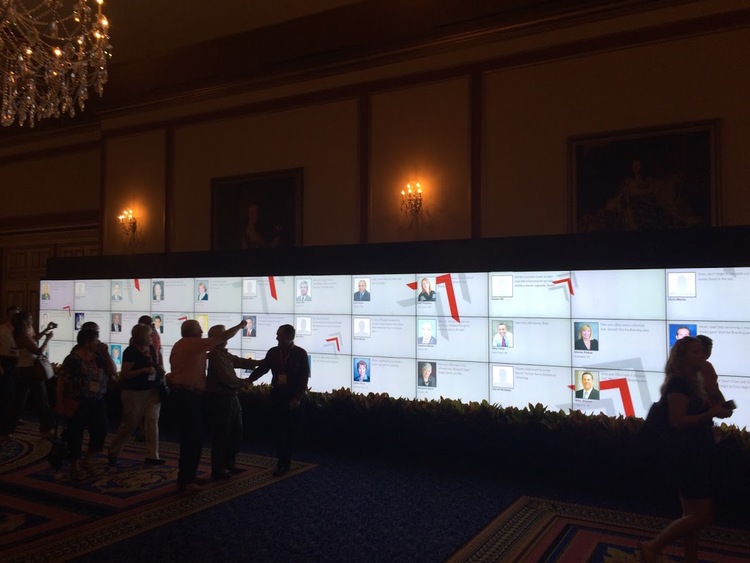
Innovative Tech For Events And How One Company Made a Business of It
It’s easy to resist change sometimes. For so long I rolled my eyes when I thought of interactive technologies.
Because a lot of them seemed to come on the scene at the same time, I assumed that companies were riding a wave of gimmicks and hot young things to make a quick buck.
That said, I’ve always found that the easiest way to get rid of a bias is to humanise what you’ve made your assumption about. I spoke with Margot from Gramercy Tech. Since 2003, the business has built itself on being ahead of the curve when it comes to their service offerings.
“Anything is possible”
…were the first words Margot said when I asked her to tell me a little about Gramercy Tech and her role with the company. This is the kind of attitude I needed to experience.
Across the virtual table, this boutique agency in NYC was making its way in the world with 40 employees off the back of innovative tech for events, and their clients kept coming back:
“We start with a client and most of the time it’s for an event and it’s on a one-off basis; we can allocate a set of resources to create a pop-up activation. From there it almost always builds to more and more and more.”
That kind of sustainability isn’t symptomatic of one person sticking on a headset at a booth, so I wanted to dig into the kind of new, innovative technologies that have the biggest and best place in the events world today.

“Everything we do makes an event more engaging. We have built this company as a experiential firm first. We’ve built apps, games, even a virtual casino. It’s ever-evolving because we build things off of the ever growing experiences we have programmed”
So, what kind of innovations in live technologies work in the events world today? Margot spoke to us about three trending versions:
1) APPS
Event apps are the bread and butter of what Gramercy provides. Their customisable iteration is called Paperless.Events, and Margot tells me it’s quite flexible:
“The app can be used, not just for an event, but for internal holding of all kinds of information. A client could potentially host 20 out-of-town tradeshows using it. They can email all the information to their teams, and keep all the information in there, which is really helpful to them.”
And, they don’t limit themselves to providing for one vertical:
“For pharmaceutical companies, we need to educate all their clients and keep them certified, which the apps we make can also provide.”
For consumer shows they have made a few fan fest “Con” apps, and the average time spent with engagement of the app is 8 minutes per user per day.
And none of their work is speculative, nor does it go unmeasured; Margot had the number at top of mind the whole way through our conversation:
2) REACTION WALLS
“We just programmed an installation for Comedy Central – whenever a certain president tweeted screens lit up, sirens blared and lights went off in the venue automatically. Everyone cheered.”
Video courtesy of the Gramercy Tech website
Coming from a marketing background, I’m hard-wired to ask about the returns something like this can produce, no matter how entertaining they were. The general consensus is that Twitter walls increase engagement and, as a result, work as good brand-building exercise and promote social sharing.
Margot and her team had yet another, yet more specific strategy:
“If the audience allows us to use beacons and Bluetooth, we can show ROI in terms of how long an attendee stays in the room, and when they leave the room. We can also do this using facial recognition on reaction walls. We can tell how long people stay in front of the interactive app.”
3) VR
“There’s very little that can engage and transport people during a live event like AR and VR can. Our mixed reality work is highly customisable, and will definitely be expanding as demand continues to grow!”
Perhaps one of the most resonant images associated with interactive technologies is the VR headset. Where there were once numbers to support my knee-jerk reaction that they were a passing fad, the last few months have proven me wrong. For the first time, over 1 million headsets were sold in a single quarter.
There are (if you excuse the pun) virtually limitless ways to use a headset in an event or conference scenario. Things like:
- Training
- Demoing
- Modeling
- Prototyping
- Design
While these tasks are entertaining and enlightening, for those providing VR as a service, how do you quantify another reality?
“For AR and VR, we use heat mapping to track how someone is interacting with the interface.”
Between their recurring custom, their employee growth, and Margot’s confidence, it was easy for me to see that, not only are new technologies a developing foundation of interactive experiences at events, so too can they be justified.
Like I say, it’s easy to resist change, but the challenges of creativity are far outweighed by the satisfaction of seeing an audience light up after seeing something new for the first time.
We’ll be publishing additional interviews and articles in this series to give you more inspiration for your own innovation at events. Stay tuned.